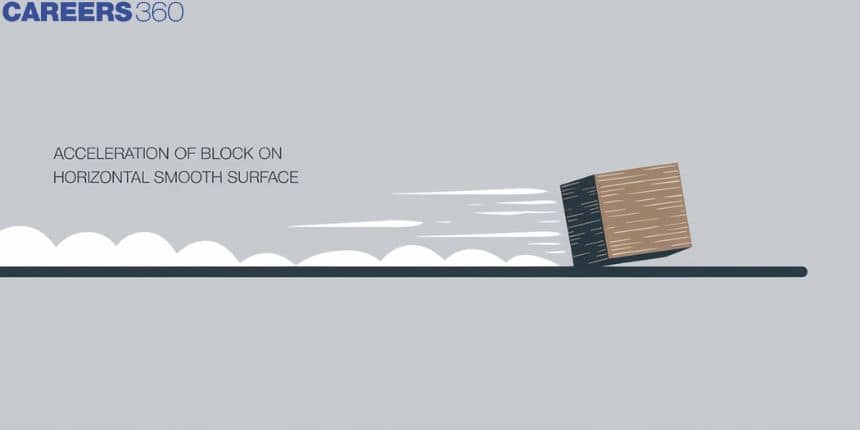Acceleration Of Block On Horizontal Smooth Surface
When a block rests on a horizontal smooth surface, it represents an ideal scenario in physics where friction is absent, allowing us to focus purely on the effects of applied forces. When an external force acts on the block, it accelerates in the direction of the force, following Newton's second law of motion. This concept is crucial in understanding the dynamics of motion and can be observed in various real-life situations. For example, consider a hockey puck sliding across an ice rink—a near-frictionless surface similar to our smooth surface. The puck continues to move swiftly when struck because of the minimal resistance, much like our block, highlighting the direct relationship between force and acceleration in a frictionless environment.
This Story also Contains
- Free Body Diagram (FBD)
- Solved Examples Based on Acceleration of Block on Horizontal Smooth Surface
- Summary

Free Body Diagram (FBD)
In this diagram, the object of interest is isolated from its surroundings and the interactions between the object and the surroundings are represented in terms of forces. After drawing FBD, Choose the axes and write the equation of motion. This is very helpful while solving questions.
Example
1. When the pull is horizontal, and no friction

Balance forces
the body is move along the X-axis
$\begin{aligned} & \because F_y=0 \\ & R=m g \quad \& \quad F=m a \\ & a=\frac{F}{m}\end{aligned}$
2. Pull Acting at Angle (Upward)

Balancing forces in both X and Y directions,
$\begin{aligned} & R+F \sin \theta=m g \\ & R=m g-F \sin \theta \text { along } \mathrm{Y} \text {-axis } \\ & F \cos \theta=m a \text { along } \mathrm{X} \text {-axis } \\ & a=\frac{F \cos \theta}{m}\end{aligned}$
3. Push Acting at Angle (Downward)

Balancing forces in both X and Y directions,
$\begin{aligned} & R=m g+F \sin \theta \text { along } \mathrm{Y} \text {-axis } \\ & a=\frac{F \cos \theta}{m} \text { along } \mathrm{X} \text {-axis }\end{aligned}$
Recommended Topic Video
Solved Examples Based on Acceleration of Block on Horizontal Smooth Surface
Example 1: A pulling force F = 50 N acting on a block of mass 5 Kg at an angle of 370 with horizontal as shown in the figure. the velocity of the block (in m/s) after 5 sec will be (assume initially block is at rest)

1) 40
2) 20
3) 10
4) 50
Solution :
Free body diagram of given block :

Horizontal component of the force, $\left(F_x\right)=F \cos 37^{\circ}=50 \times \frac{4}{5}=40 \mathrm{~N}$
Vertical component of the force, $\left(F_y\right)=F \sin 37^{\circ}=50 \times \frac{3}{5}=30 \mathrm{~N}$
Acceleration fo the block, (a) $=\frac{\text { component of force in the direction of acceleration }}{\text { mass }}$
$
a=\frac{40}{5}=8 \mathrm{~m} / \mathrm{s}^2
$
Now, from the equation of motion
$
\begin{aligned}
& v=u+a t \\
& v=0+8 \times 5=40 \mathrm{~m} / \mathrm{s}
\end{aligned}
$
Hence the answer is the option (1).
Example 2: A block of mass 5 Kg is at rest on a horizontal smooth surface. A constant force F = 10 N is applied horizontally on the block then the displacement (in meters) of the block after 2 sec will be
1) 4
2) 10
3) 8
4) 5
Solution :
Given :
Mass, $(\mathrm{m})=5 \mathrm{~kg}$
Initial velocity, $(\mathrm{u})=0$
Horizontal force, $(\mathrm{F})=10 \mathrm{~N}$
Time, $(\mathrm{t})=2 s$
Displacement, $(\mathrm{s})=$ ?
Free body diagram of given block :

$
\begin{gathered}
F=m a \\
\therefore a=\frac{F}{m}=\frac{10}{5}=2 \mathrm{~m} / \mathrm{s}^2
\end{gathered}
$
Now, applying 2nd equation of motion-
$
\begin{aligned}
& s=u t+\frac{1}{2} a t^2 \\
& s=0+\frac{1}{2} \times 2 \times 2^2 \\
& \Rightarrow s=4 m
\end{aligned}
$
Hence the answer is the option (1).
Example 3: In Fig, if the surfaces are frictionless

Tension (in N) will be:
1) 6.17
2) 3.37
3) 6
4) 10
Solution :

Let a be the horizontal acceleration of the whole system due to the horizontal component of force $F \cos 60^{\circ}$
$
\therefore a=\frac{\text { Net force along horizontal direction }}{\text { Total mass }}=\frac{F \cos 60^{\circ}}{7+12+15}=\frac{30}{34}=\frac{15}{17} \mathrm{~m} / \mathrm{s}^2
$
FBD of the 7 Kg block :

Using Newton's second law,
$
T_2=m a=7 \times \frac{15}{17}=6.17 N
$
Hence the answer is the option (1).
Example 4: Two blocks of mass 5kg and 5kg are connected by a string of mass 2kg as shown in Fig. Point Q is the midpoint of the string. A pulling force of 24N is applied on block 5kg at an angle of $60^{\circ}$ with horizontal. The tension (in N) at point Q is (all surfaces are frictionless).

1) 6
2) 10
3) 5
4) 10
Solution :

Let a be the horizontal acceleration of the whole system due to the horizontal component of force $F \cos 60^{\circ}$
$
\therefore a=\frac{\text { Net force along horizontal direction }}{\text { Total mass }}=\frac{24 \cos 60^{\circ}}{5+5}=\frac{12}{10}=\frac{5}{6} \mathrm{~m} / \mathrm{s}^2
$
FBD of the 5 Kg block

Using Newton's second law,
$
T=m a=5 \times \frac{6}{5}=6 N
$
Hence the answer is the option (1).
Example 5: A force of 50N acts in the direction shown in Fig. The block of mass of 5kg rests on a smooth horizontal surface. What is the acceleration of the block?

1) $5 \mathrm{~m} / \mathrm{s}^2$
2) $8 m / s^2$
3) $5 \sqrt{3} \mathrm{~m} / \mathrm{s}^2$
4) $10 \mathrm{~m} / \mathrm{s}^2$
Solution :
Free body diagram of the given system :

Horizontal component of the force $=F \sin \theta=50 \sin 60^{\circ}=\frac{50 \sqrt{3}}{2} N$ acceleration of the block, (a) $=\frac{F \sin \theta}{M}=\frac{\frac{50 \sqrt{3}}{2}}{5}=5 \sqrt{3} \mathrm{~m} / \mathrm{s}^2$
Hence the answer is the option (3).
Summary
The article explains the concept of acceleration of a block on a horizontal smooth surface, emphasizing the importance of understanding force and motion through Free Body Diagrams (FBD). It includes examples that demonstrate how to calculate velocity, displacement, tension, and acceleration when forces are applied to blocks on frictionless surfaces, providing practical applications of Newton's laws of motion